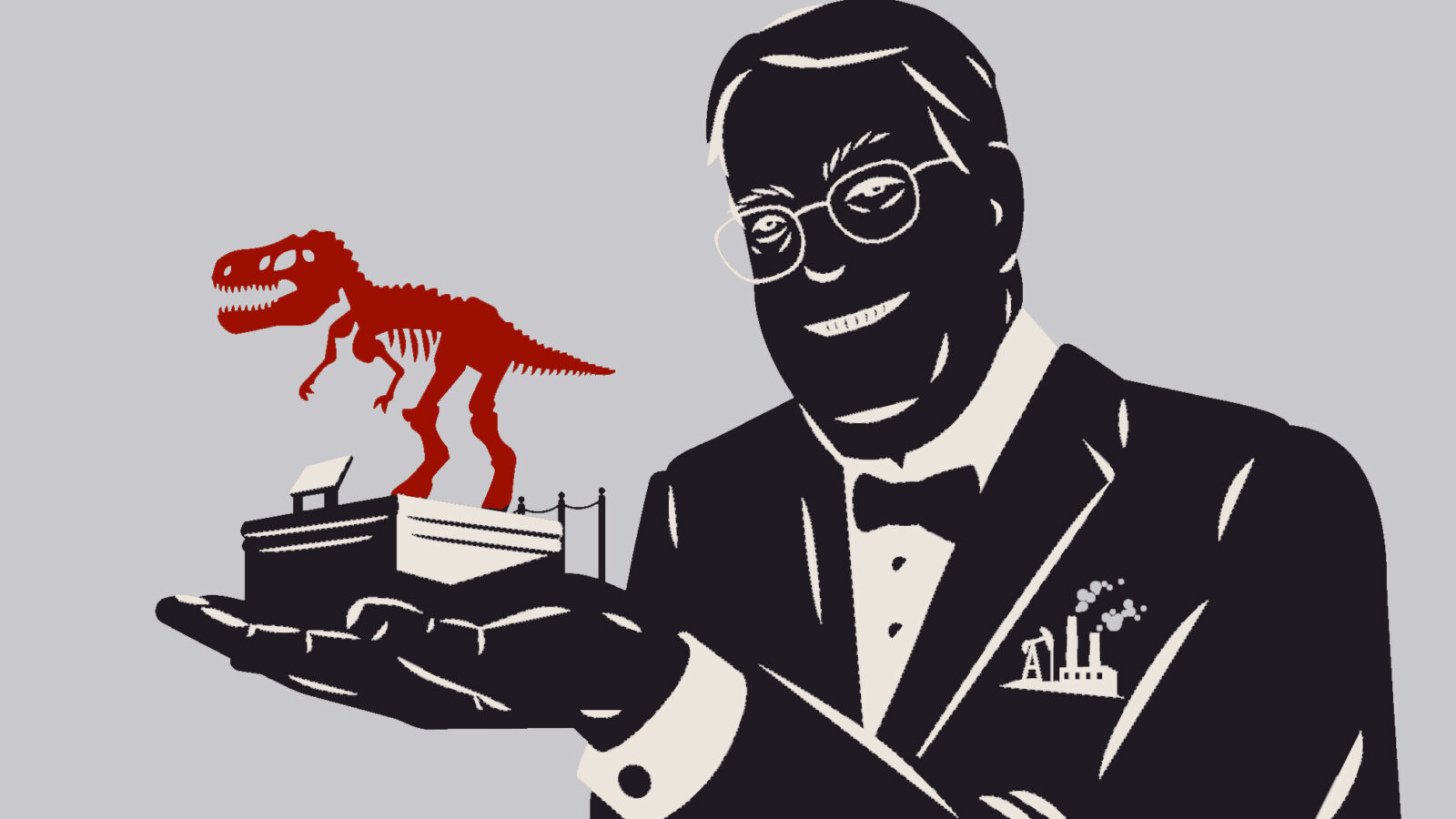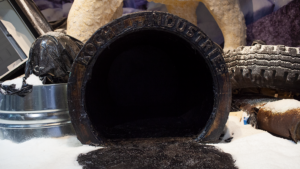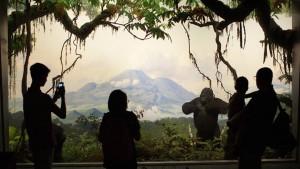Originally posted on September 14th, 2014 in Vice Magazine
By Mary Emily O’Hara

The Natural History Museum’s mobile tour. The new project’s opening is Saturday at the Queens Museum.
What is the point of a science museum? If you’ve visited the American Museum of Natural History in Manhattan recently, you might think it was designed to collect dust: moldy, ancient dioramas of cavemen stare out of lit-up boxes that don’t appear to have been entered by museum staff since the 1970s.
But ask Brooklyn arts collective Not An Alternative, who are launching a new project on Saturday with a kickoff event at the Queens Museum, and they’ll tell you a science museum should be on the front lines of addressing issues that affect the natural world, like climate change. And, they say, what it most definitely should not be doing is taking huge donations from oil companies that are behind the climate change denial movement.
The Natural History Museum became the newest member of the American Alliance of Museums this week. It’s a multi-year project that retools the traditional model of taxidermied beasts and ancient anthropological history to present an evolving view of scientific challenges that doesn’t whitewash politics. The Queens Museum launch, a month-long series of events and lectures timed to coincide with the September 21 People’s Climate March, focuses on climate change and critical views of museum ethics.
[Speaking of ethics, here’s a disclaimer: Not An Alternative runs a co-working office in Brooklyn called No Space, and I rent a desk there.]
Ethics undoubtedly come into question when you consider that oil magnate David Koch of atmosphere-clogging Koch Industries sits on the boards of both the American Museum of Natural History (AMNH) and the Smithsonian. Koch’s arts philanthropy extends beyond just science museums; this month the Metropolitan Museum of Art unveiled the new David H. Koch plaza while activists projected anti-Koch ‘light graffiti’ onto the museum. Koch’s name is also emblazoned on the city’s premier ballet venue.
But it is Koch’s prominent place within the controlling entities behind the nation’s two high-profile natural history museums that creates what many say is an unforgivable conflict of interest.
“There’s a contradiction there between the ideals of the institution and its practice,” Not An Alternative’s Beka Economopoulos told VICE in an interview. “Why would one of the biggest funders of groups that deny or misrepresent climate science and biggest contributors to climate pollution be sitting on the board of a museum whose mission is to celebrate nature?”
While the Koch brothers’ financial backing of the conservative Tea Party movement has been well documented, revelations of their massive funding of climate change-denying organizations is less so. In 2012, Greenpeace reported that the Kochs had funneled over $61 million into a variety of scientific front groups. The next year, a Drexel University study found that of the $558 million in funding provided to climate denial groups between 2003 and 2010, the biggest donors were ExxonMobil and—you guessed it—Koch Industries.
VICE reached to out Koch Industries for comment but did not receive a response. The Smithsonian and AMNH didn’t get back to us either.
“You have more of these donors from the 1 percent who are embedding themselves in our cultural institutions and yet turning around and lobbying for the sequester and budget cuts for those same institutions,” Economopoulos said.
Museums and other arts institutions are constantly battling the twin demons of a lack of state funding and ethically-compromising corporate sponsorship, and the economic stress has only increased since the financial crisis. Elizabeth Merritt, director of the American Alliance of Museums’ Center for the Future of Museums, explained that in the eyes of the public, there’s a fine line between receiving corporate gifts and taking hush money.
“If significantly wealthy individuals are the source of money museums rely on, are they relying on the interests of the public?” Merritt asked.
“If a major executive of a tobacco company offered to serve on the board of a children’s museum,” Merritt continued, “wouldn’t that be a mismatch between the mission of serving the health of children and that company’s mission?”
The fundamental aim of most science and natural history museums is to educate the public about the natural world. But critics say museums aren’t catching up to the times, refusing to address the root causes of the impending doom that is pollution-driven climate change—much less offering solutions to the problem.
The artists and activists at Not An Alternative stress that they are serious about founding a legitimate science museum. And that means working with some of the top climate change experts in the scientific community to curate programming.
One of those scientists is meteorologist and author Michael Mann, who will take part in a September 27 panel discussion on “The Propaganda of Debate” at the Queens Museum.
“We cannot allow agenda-driven oil barons like the Koch brothers to be self-appointed arbiters of what the public is taught about science,” Mann told VICE, adding that he found Koch’s funding of the AMNH’s Dinosaur Wing ironic because “David and his brother Charles are arguably doing more than any other human beings on the planet to return us to the greenhouse gas levels and extreme climate of the age of the dinosaurs.”
Mann is far from the only prominent scientist to be horrified by the museum community’s relative silence on the climate change.
In an April 2010 video, climatologist Joseph Romm walks through the Smithsonian’s David H. Koch Hall of Human Origins and ‘learns’ that human evolution was at its best during times of extreme climate shifts. He suggests that the entire exhibit was a front for denying the potential dangers of climate change—and for boosting the perception that global warming is not only harmless, but maybe even beneficial to humanity.
“The exhibit puts the credibility of the entire Museum of Natural History and science staff on the line,” Romm wrote in an accompanying article. “Either the exhibit should be completely reworked or they should give Koch’s money back so as not to taint this exhibit. Or both.”
It’s interesting that the exhibit doesn’t try to explicitly deny global warming so much as reframe it as a natural aspect of evolution that might have positive effects on the environment—a version of history with which almost any climate scientist in the world would vehemently disagree.
“It’s about what gets funded and what doesn’t get funded,” Economopoulos said. “The politics isn’t in the science itself—science is raw data, as close to the truth as you can get. The funding is about how we are interpreting that knowledge to further an agenda. Our museum doesn’t try to obfuscate that fact.”
This June, Museum Management and Curatorship editor Robert Janes called for museums to directly address climate change. In a videotaped speech released by Future of Museums, Janes scolded his community for “sleepwalking into the future.”
“We’ve now reached the threshold of 400 parts per million of carbon in the atmosphere for the first time in human history… a dire wake up call for each of us to adopt clean energy technology and reduce our carbon emissions,” Janes warned, accusing science and natural history museums of focusing too much on keeping up with the latest gadgets and not enough on threats to the natural world as we know it.
“No amount of digital technology, gaming, or robotics will be of any use if the biosphere dissolves,” he said.
The Natural History Museum’s grand opening party is this Saturday, September 13 from 5-8pm at the Queens Museum.
Follow Mary Emily O’Hara on Twitter.





